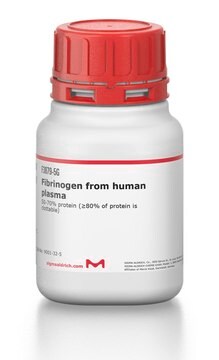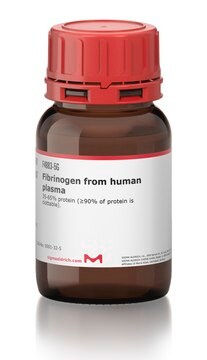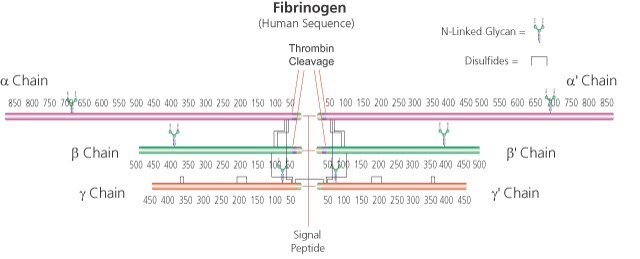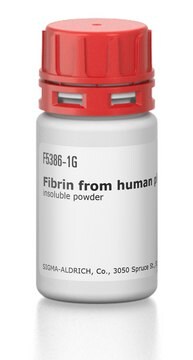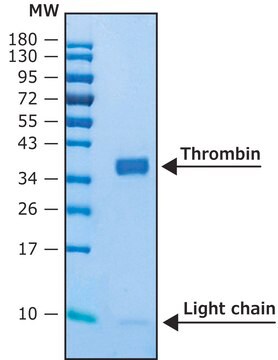F6755
Fibrinogen from rat plasma
60-80% protein (≥60% of protein is clottable)
Synonim(y):
Factor I
Zaloguj sięWyświetlanie cen organizacyjnych i kontraktowych
About This Item
Polecane produkty
pochodzenie biologiczne
rat plasma
Poziom jakości
Formularz
powder
jakość
60-80% protein (≥60% of protein is clottable)
masa cząsteczkowa
α-chain 63.5 kDa
β-chain 56 kDa
γ chain 47 kDa (about 4% carbohydrate content)
soluble dimer 340 kDa
stężenie
60-80% (biuret)
metody
cell culture | mammalian: suitable
immunoblotting: suitable
temp. przechowywania
−20°C
informacje o genach
rat ... Fga(361969) , Fgb(24366) , Fgg(24367)
Zastosowanie
Fibrinogen from rat plasma has been used:
- in the preparation of growth factor solutions
- to apply on discontinuous SDS-polyacrylamide gels for the detection of IgG (immunoglobulins) type antibodies by immunoblot analysis
- to mix with cell suspension to form a clot and retain the cells for avoiding its dispersion during transplantation
Fibrinogen has been used in studies of haemostatic therapy in surgical and massive trauma patients. These studies have shown that fibrinogen may prove to be more superior in stopping blood loss when compared to using fresh frozen plasma (FFP).
Działania biochem./fizjol.
Acute phase protein that is part of the coagulation cascade of proteins.
Fibrinogen is an acute phase protein that is part of the coagulation cascade of proteins. The end result of the cascade is the production of thrombin that converts fibrinogen to fibrin. Thrombin rapidly proteolyses fibrinogen, releasing fibrinopeptide A. The loss of this small peptide is not sufficient to make the resulting fibrin molecule insoluble, but it tends to form complexes with adjacent fibrin and fibrinogen molecules. Thrombin then cleaves a second peptide, fibrinopeptide B, from fibrin and the fibrin monomers formed then polymerize spontaneously to form an insoluble gel. The polymerized fibrin is held together by noncovalent and electrostatic forces and stabilized by the transamidating enzyme, factor XIIIa, that is produced by the action of thrombin on factor XIII. The insoluble fibrin aggregates (clots) and aggregated platelets then block the damaged blood vessel and prevent further bleeding. The amount of fibrinogen in the plasma can serve as a nonspecific indicator of whether or not an inflammatory process is present in the body. Fibrinogen from any mammalian source will be cleaved by thrombin from any mammalian source.
Jakość
Contains ~12% sodium citrate and ~18% sodium chloride.
Komentarz do analizy
Protein determined by biuret.
Ta strona może zawierać tekst przetłumaczony maszynowo.
Kod klasy składowania
11 - Combustible Solids
Klasa zagrożenia wodnego (WGK)
WGK 3
Temperatura zapłonu (°F)
Not applicable
Temperatura zapłonu (°C)
Not applicable
Środki ochrony indywidualnej
Eyeshields, Gloves, type N95 (US)
Wybierz jedną z najnowszych wersji:
Masz już ten produkt?
Dokumenty związane z niedawno zakupionymi produktami zostały zamieszczone w Bibliotece dokumentów.
Klienci oglądali również te produkty
Cell Transplantation as a Method to Investigate Spinal Cord Regeneration in Regenerative and Nonregenerative Xenopus Stages
Mendez-Olivos EE and LarraIn J
Cold Spring Harbor Protocols (2018)
Optimization of trophic support for neural stem cell grafts in sites of spinal cord injury
Robinson J and Lu P
Experimental Neurology, 291, 87-97 (2017)
Salmon fibrin glue in rats: antibody studies
Laidmae I, et al.
Biologicals : Journal of the International Association of Biological Standardization, 40(1), 55-60 (2012)
C Fenger-Eriksen et al.
British journal of anaesthesia, 101(6), 769-773 (2008-09-27)
Patients experiencing massive haemorrhage are at high risk of developing coagulopathy through loss, consumption, and dilution of coagulation factors and platelets. It has been reported that plasma fibrinogen concentrations may reach a critical low level relatively early during bleeding, calling
Richard J Fish et al.
Blood, 123(14), 2278-2281 (2014-02-21)
Mutations in the human fibrinogen genes can lead to the absence of circulating fibrinogen and cause congenital afibrinogenemia. This rare bleeding disorder is associated with a variable phenotype, which may be influenced by environment and genotype. Here, we present a
Nasz zespół naukowców ma doświadczenie we wszystkich obszarach badań, w tym w naukach przyrodniczych, materiałoznawstwie, syntezie chemicznej, chromatografii, analityce i wielu innych dziedzinach.
Skontaktuj się z zespołem ds. pomocy technicznej